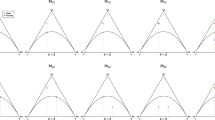Abstract
We consider testing independence in group-wise selections with some restrictions on combinations of choices. We present models for frequency data of selections for which it is easy to perform conditional tests by Markov chain Monte Carlo (MCMC) methods. When the restrictions on the combinations can be described in terms of a Segre–Veronese configuration, an explicit form of a Gröbner basis consisting of binomials of degree two is readily available for performing a Markov chain. We illustrate our setting with the National Center Test for university entrance examinations in Japan. We also apply our method to testing independence hypotheses involving genotypes at more than one locus or haplotypes of alleles on the same chromosome.
Similar content being viewed by others
References
Aoki S., Takemura A. (2005) Markov chain Monte Carlo exact tests for incomplete two-way contingency tables. Journal of Statistical Computation and Simulation 75: 787–812
Aoki, S., Takemura, A. (2006). Markov chain Monte Carlo tests for designed experiments. arXiv:math/0611463v1 (submitted).
Aoki, S., Takemura, A. (2008). Minimal invariant Markov basis for sampling contingency tables with fixed marginals. Annals of the Institute of Statistical Mathematics. (to appear). doi:10.1007/s10463-006-0089-x.
Aoki, S., Hibi, T., Ohsugi, H., Takemura, A. (2007). Gröbner bases of nested configurations. arXiv: math/0801.0929v1 (submitted).
Beerenwinkel N., Eriksson N., Sturmfels B. (2007) Conjunctive Bayesian networks. Bernoulli 13: 893–909
Bishop Y.M.M., Fienberg S.E., Holland P.W. (1975) Discrete multivariate analysis: theory and practice. The MIT Press, Cambridge
Crow J.E. (1988) Eighty years ago: The beginnings of population genetics. Genetics 119: 473–476
De Negri E., Hibi T. (1997) Gorenstein algebras of Veronese type. Journal of Algebra 193(2): 629–639
Diaconis P., Sturmfels B. (1998) Algebraic algorithms for sampling from conditional distributions. The Annals of Statistics 26: 363–397
Guo S., Thompson E. (1992) Performing the exact test of Hardy–Weinberg proportion for multiple alleles. Biometrics 48: 361–372
Hastings W.K. (1970) Monte Carlo sampling methods using Markov chains and their applications. Biometrika 57: 97–109
Hibi T. (1987) Distributive lattices, affine semigroup rings and algebras with straightening laws. Advanced Studies in Pure Mathematics 11: 93–109
Huber M., Chen Y., Dinwoodie I., Dobra A., Nicholas M. (2006) Monte Carlo algorithms for Hardy–Weinberg proportions. Biometrics 62: 49–53
Lehmann E.L., Romano J.P. (2005) Testing statistical hypotheses, (3rd ed.) . Springer, New York
National Center for University Entrance Examinations. (2006). Booklet on NCUEE. http://www.dnc.ac.jp/dnc/gaiyou/pdf/youran_english_H18_HP.pdf.
Oguma T., Palmer L.J., Birben E., Sonna L.A., Asano K., Lilly C.M. (2004) Role of prostanoid DP receptor variants in susceptibility to asthma. The New England Journal of Medicine 351: 1752–1763
Ohsugi H., Hibi T. (2000) Compressed polytopes, initial ideals and complete multipartite graphs. Illinois Journal of Mathematics 44: 391–406
Ohsugi H., Hibi T. (2005) Indispensable binomials of finite graphs. Journal of Algebra and Its Applications 4: 421–434
Ohsugi, H., Hibi, T. (2007). Toric ideals arising from contingency tables. In: Commutative Algebra and Combinatorics, Ramanujan Mathematical Society Lecture Notes Series, Number 4, Ramanujan Mathematical Society, India (in press).
Ohsugi, H., Hibi, T. (2008). Quadratic Gröbner bases arising from combinatorics. Integer Points in Polyhedra—Geometry, Number Theory, Representation Theory, Algebra, Optimization, Statistics. In Contemporary Mathematics (Vol. 452, pp. 123–138). New York: American Mathematical Society.
Pachter L., Sturmfels B. (2005) Algebraic statistics for computational biology. Cambridge University Press, Cambridge.
Rapallo F. (2006) Markov bases and structural zeros. Journal of Symbolic Computation 41: 164–172.
Ripley B.D. (1987) Stochastic simulation. Wiley, New York
Sturmfels, B. (1995). Gröbner bases and convex polytopes. Providence: American Mathematical Society.
Takemura A., Aoki S. (2004) Some characterizations of minimal Markov basis for sampling from discrete conditional distributions. Annals of the Institute of Statistical Mathematics 56: 1–17.
Author information
Authors and Affiliations
Corresponding author
About this article
Cite this article
Aoki, S., Hibi, T., Ohsugi, H. et al. Markov basis and Gröbner basis of Segre–Veronese configuration for testing independence in group-wise selections. Ann Inst Stat Math 62, 299–321 (2010). https://doi.org/10.1007/s10463-008-0171-7
Received:
Revised:
Published:
Issue Date:
DOI: https://doi.org/10.1007/s10463-008-0171-7




